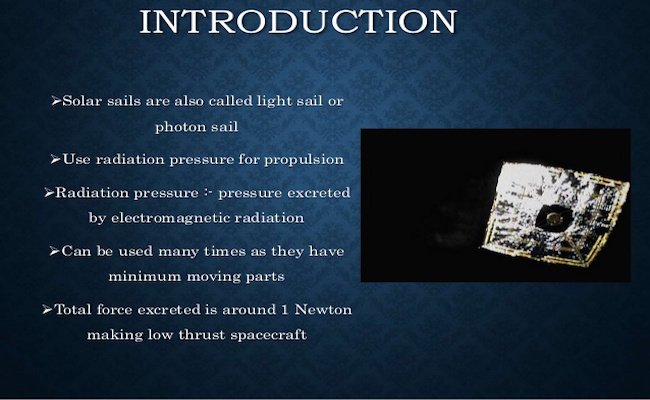Light Driven Nano Spaceships

Imagine tiny spacecraft traveling through space powered by the light of the sun. Can scientists develop ultra-fast light-driven nano-spacecraft? Read on to learn more about nano spaceships.
Researchers want to figure out how to get spacecraft to travel as fast as light. Since the creation of Star Trek and Warp drive the desire and determination to reach planets light years away has motivated hundreds of astronomers.
Solar Sails
Solar sails or nano spaceships, may provide the solution to question, “How do we travel at light speed?” These light sails or photon sails use radiation pressure put off by sunlight to move them forward. The vehicles have large mirrors on them that capture the light emitting from the sun. The light pushes the vehicle through space similar to a sailboat pushed along by the wind. Another way to propel the tiny vehicles forward would involve laser beans. The concentration of laser beams would exert a greater force on the sails, far more than sunlight would allow. Solar sail crafts contain few moving parts. They do not have a propellant and therefore their ability to make repeated trips is possible.

Credit:kanav mansotra
Credit:kanav mansotraWho Conceived the Idea of Solar Sails?
Many men worked on the concept of solar sails. Each one of the men listed below advanced theories that today have allowed researchers to build these nano spaceships.
- Johannes Kepler observed that comet tails point away from the Sun and suggested that the Sun caused the effect. In a letter to Galileo in 1610, he wrote, “Provide ships or sails adapted to the heavenly breezes, and there will be some who will brave even that void.”
- James Clerk Maxwell, in 1861–64, published his theory of electromagnetic fields and radiation, which shows that light has momentum and thus can exert pressure on objects.
- Jules Verne, in From the Earth to the Moon, published in 1865, wrote “there will some day appear velocities far greater than these [of the planets and the projectile], of which light or electricity will probably be the mechanical agent … we shall one day travel to the moon, the planets, and the stars.”
- Pyotr Lebedev – first to successfully demonstrate light pressure, which he did in 1899 with a torsional balance.
- Svante Arrhenius predicted in 1908 the possibility of solar radiation pressure distributing life spores across interstellar distances, providing one means to explain the concept of panspermia. He stated that light could move objects between stars.
- Albert Einstein (1912) provided a different formalism by his recognizing the equivalence of mass and energy. He wrote the relation p = E/c relating the momentum p and the energy E of a photon, where c is the speed of light.
- Konstantin Tsiolkovsky first proposed using the pressure of sunlight to propel spacecraft through space and suggested, “using tremendous mirrors of very thin sheets to utilize the pressure of sunlight to attain cosmic velocities”.
Breakthrough Starshot
A research group named Breakthrough Initiatives is currently working to develop a fleet of light sail spacecraft. Named StarChip, these space crafts will be capable of making the journey to the Alpha Centauri star system. If their nano spaceship can reach speeds 15% to 20% the speed of light, they can reach Alpha Centauri at 4.37 light years away. They believe it will take four years for the knowledge to reach them that the trip was a success.
The nano spaceships measure on the scale of centimeters and weigh a few grams. Once the sails launch, the group will focus ground based lasers on the crafts to accelerate them across space. With tiny cameras on board, they hope to capture high-quality surface features of Earth size planets orbiting in the Alpha Centauri system. By launching 1000 ships they hope to have enough to survive the journey through space debris and interstellar dust.
With these great initiatives, we may see other galaxies in our lifetime. With great determination and some luck, it will be exciting to see how the nano spaceships accomplish their mission.
